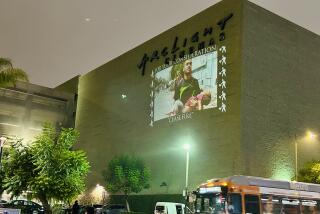Arcade Fire proves camera ready
“Say, ‘Hi, Internet!’ ” Win Butler of the Arcade Fire urged the crowd at Madison Square Garden on Thursday night. “Let’s show ‘em what they’re missing!” His rallying cry was oddly peevish, considering that this second night of the Canadian ensemble’s headlining debut at New York’s famed sports arena was being webcast worldwide, with top filmmaker Terry Gilliam serving as director. Yet it struck the core of what makes the Arcade Fire crucial to so many young (and young-hearted) rock fans: the power of voices and bodies moving molecules together, which can’t be replicated in cyberspace.
That impossibility of capturing the energy of what might now be rock’s most emotionally powerful live band was the challenge Gilliam took on when he agreed to helm the webcast as part of the new American Express-sponsored series “Unstaged,” shown on Vevo via YouTube. In typical jester fashion, the Monty Python circus master ended up playing with the concert film form instead, creating collage images of the group and its stage effects that enhanced the sometimes nearly incoherent intensity of their surging songs.
Just as often, Gilliam simply focused his cinematically sharp “robot cameras” on Butler’s hayseed-prophet face, or on the seven band members lined up in a row shouting their hearts out while banging on everything from a marching-band drum to a violin to a synthesizer to their own heaving chests. The man who brought the world “The Adventures of Baron Munchausen” knows constructive chaos when he sees it.
The Arcade Fire’s recordings aren’t really iconoclastic. On the band’s new album, “The Suburbs,” and on its two previous releases, Butler and his wife and main songwriting partner, the multi-instrumentalist Régine Chassagne, have favored repetitive, accelerating song structures that connect to rock’s roots the same way the Velvet Underground and Sonic Youth once did: artily, through minimalism and clangy post-punk. When played by the large ensemble that is the Arcade Fire in concert, these songs become the channels through which listeners shed their inhibitions and connect to each other. “I’ll dig a tunnel from my window to yours,” Butler sang in “Neighborhood #1 (Tunnels)”; that’s what his music does.
The bohemian side of pop has long relied on this idea that music builds and supports communities that can be both utopian and sweatily real, populated by rebels whose everyday choices — what they wear, whom they romance or befriend, whether they get “real” jobs — evolve into something like a spiritual practice.
From the Summer of Love to the springtime of U2 to the restless autumns of Pearl Jam and Radiohead, rock has renewed itself through the conviction that what it promises is more than the simple pleasures of shiny, disposable pop.
But there must be pleasure too. The Arcade Fire offers one of the oldest kinds: the chance to open your mouth wide and sing, and to loosen your limbs and dance. Butler has a religious studies degree, and the band’s songs do resemble hymns, with some Afro-Caribbean rhythms and Bo Diddley voodoo thrown in for good measure.
“The Suburbs” is not Arcade Fire’s best album. It takes on a theme — middle-class conformity, as defined by families and the homes where they grow or fester — that predecessors like Bruce Springsteen and Green Day have done with more humor and attention to specifics. And its echoing production obscures the empathetic interplay that makes this family band such a model of collaboration.
The qualities that weaken the album, though, help the Arcade Fire in performance. Like another of its parents, U2, the group puts forth music abstract enough — open enough — for any sympathetic listener to imagine as her own heart’s cry. And it’s impossible to not be sympathetic to these nice-looking kids, captured in Gilliam’s webcast as all pink-lipped and glowy, pure heroes in a complicated world.
The members of the Arcade Fire not only give this gift to their fans, they enact it onstage. Gilliam’s cameras captured them zigzagging around, switching instruments, shaking their shiny mops of hair as they sang, full force, in unison or ragged harmony. Butler was unquestionably the frontman, but still moved among his mates like an equal, and did the same with the crowd, balancing on a railing and reaching out to his fans for support.
When a band as convinced of rock’s enduring power as the Arcade Fire finds a cat door into the mainstream, its success feels, to its supporters, like a major blow against the cheap values of a world otherwise moving too fast. Bands like this create pockets of mythic time. In the Village Voice, the critic Rob Harvilla called the chart-topping success of “The Suburbs” and the band’s conquest of the Garden “a generational cataclysm.” He was half joking. But he’d been in that room where the tunnels had been dug, and he was also half serious.
More to Read
The biggest entertainment stories
Get our big stories about Hollywood, film, television, music, arts, culture and more right in your inbox as soon as they publish.
You may occasionally receive promotional content from the Los Angeles Times.










